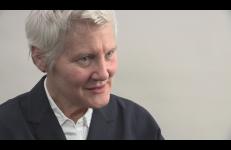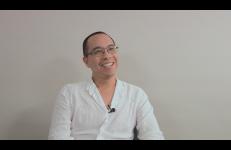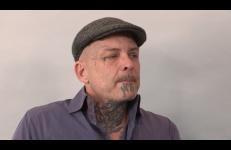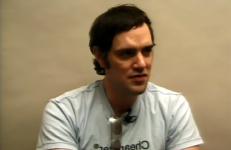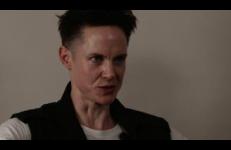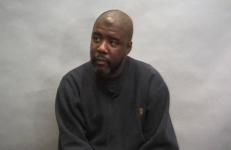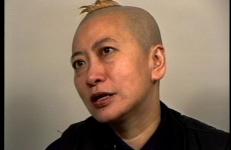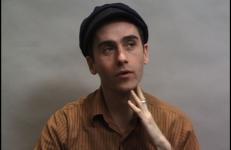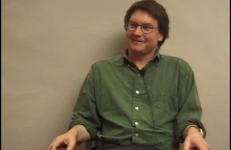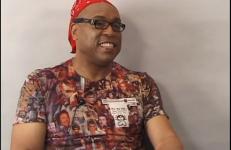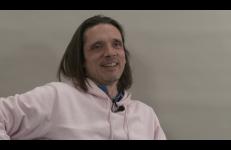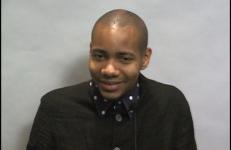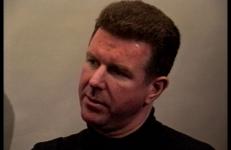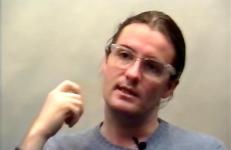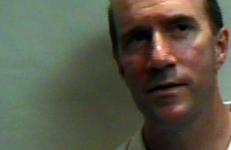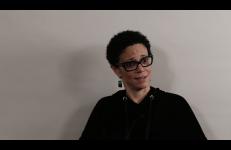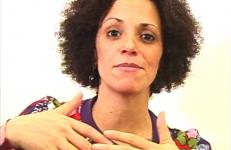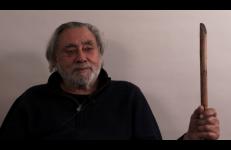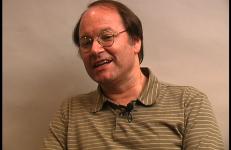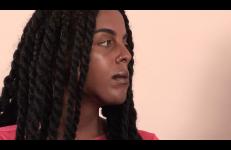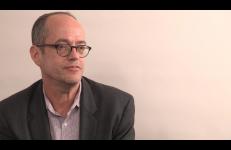In conversation with curator and educator Mary Jane Jacob, visual artist Ann Hamilton (b. 1956) talks about care, interactivity, and social relations — key concepts that preoccupy her practice — and why she feels compelled to revisit these issues under the Trump administration. Hamilton was trained in textile design and sculpture, and she received her MFA from Yale University School of Art in 1985.
Visiting Artists Program
Apichatpong Weerasethakul is a venerated Thai artist and moving image maker who has directed many short works, and several feature films. In this interview, Apichatpong and Daniel Eisenberg — a Chicago-based artist and professor of film and video at the School of the Art Institute of Chicago — discuss Apichatpong’s films along with his perspective on the contemporary film industry and art world.
In this interview, extreme performance artist and 1990s culture warrior Ron Athey (b.1961) discusses the genesis of his provocative performance style and the memories and desires that continue to motivate his practice. Athey describes how his particular approach to performance developed dually from his religious upbringing and exposure to devotional theater, as well as from his later interest in the DIY grandiosity of the Los Angeles punk scene.
In this interview, American cartoonist and author Lynda Barry (b. 1956) describes the philosophy of teaching that has inspired and mobilized her art since the 1970s. For Barry, the connection between gesture and thought collide in drawing and expose the therapeutic possibilities of art. Whether teaching undergraduate art students or prison inmates, her goal is to help others develop art making skills as an “external immune system” that will protect and monitor their emotional and mental health.
Jeremy Blake (1971-2007) used digital media to create works that function on a flexible spectrum between being more painting-like or more film-like. He created continually looping digital animations with sound to be projected or presented on plasma screens. Blake often began by making the digital C-prints, which he conceived to be somewhat like paintings; if the imagery and idea of one of these works lent itself as such, he might extrapolate from and expand on it to begin creating a digital animation, which could range from 3 to 20 minute repeating loops.
In conversation with David Getsy — an art historian focusing on queer and transgender methodologies in sculpture theory and performance history — Cassils discusses their monumental performance artworks and inspirations.
British theorist and art historian Eddie Chambers (b.1960) is a curator and a regular contributor to Art Monthly and European journals on contemporary art. His writings were collected in Run Through the Jungle (1999). Since the early 1980s he has been involved in organizing and curating a considerable number of artists' exhibitions. In addition to his exhibition work, he has written extensively about the work of artists in the United Kingdom and other countries, including Australia, Jamaica and the U.S. His articles and other texts have been widely published in magazines and journals such as Third Text, Visual Culture in Britain, International Review of African American Art, and Wasafiri.
Taiwanese artist Shu Lea Cheang (b. 1954) tackles conceptions of racial assimilation in American culture, examining the political underbelly of everyday situations that affect the relationship between individuals and society.
In this 2001 interview, filmmaker Jem Cohen discusses the origins of his film philosophy, and the circuitous route he has taken in his pursuit of an anti-narrative film practice outside the mainstream. Cohen sheds light on the many influences that have impacted his sentiments towards conventional film, and his desire to eschew both classical avant-garde and theatrical filmmaking in favor of a model rooted in the tradition of the 1940s New York School of street photography. Cohen also locates his aesthetic as being impacted by the 1970s hardcore and DIY scenes he was exposed to as a youth in Washington, DC.
Matthew Coolidge is a founder and director of The Center for Land Use Interpretation (CLUI), an organization dedicated to raising awareness about how land is apportioned, used and perceived by its inhabitants. Through exhibitions, publications, and guided tours, Coolidge and the CLUI seek to foster and encourage a heightened sense of awareness of natural surroundings. In this interview, Coolidge defines a ‘land art spillover effect,’ in which the perceived significance of the landscape seems to increase the closer people get to a piece of environmental art.
In this interview, American artist, independent curator, writer, and experimental filmmaker, Vaginal Davis reflects on her initiation into the punk rock and art scenes of Los Angeles during the 1980s and 90s, her stylistic influences, and her ongoing efforts to theorize queerness and visuality. Caught between the opposing poles of Hollywood classicism and the rawness of punk, Davis defines her unapologetically gender-bending, campy, and at times aggressively critical performances as scenarios, rather than spectacles or entertainment.
Turner Prize winning conceptual artist Jeremy Deller works across many different mediums, creating highly political and frequently collaborative works. Defying conventionality, Deller often exhibits outside of traditional gallery spaces, such as his 1993 twist on artist open studios, Open Bedroom, a secret exhibition in Deller’s family home while his parents were on holiday.
Paul D. Miller (b. 1970) is a conceptual artist, writer, and musician better known as DJ Spooky. A popular and prolific recording artist, he has collaborated with Ryuichi Sakamoto, Butch Morris, Yoko Ono, Thurston Moore (of Sonic Youth), Kool Keith, and Killa Priest (of Wu Tang Clan). Miller’s work uses a wide variety of digitally created music as a form of postmodern sculpture.
Northern Irish artist Willie Doherty (b. 1959) works in photography and video installation. Since the late 1980s, his work has responded to the urban setting and rural outskirts of his hometown of Derry, Northern Ireland. Doherty’s artworks tend to begin as responses to specific terrains (most often mysterious isolated settings; places, we suspect, with a troubled past) and evolve as complex reflections on how we look at such locations — or on what stories might be told about their hidden histories.
In this interview, political and social theorist, Terry Eagleton (b. 1943), shares stories of his Irish upbringing and British education, and sums up his current engagement with art theory, leftist politics, and spirituality under capitalism. With reference to Henry James, Frederic Jameson, Christopher Hitchens, and Richard Dawkins, among others, this interview spans a vast landscape of literature and social theory.
Berlin-based Danish artist Olafur Eliasson complicates and simulates perception through his installations, sculptures, and photographs. He has created disorienting artificial illuminations and reproduced natural phenomena such as clouds, glaciers and the sun through large-scale, high-tech installations.
Hal Foster is Professor of Modern Art at Princeton University, and has written and edited numerous influential books on postmodernism, art, and culture. His books include Recodings: Art, Spectacle, Cultural Politics (1985); The Return of the Real: The Avant-Garde at the End of the Century (1996); and, as editor, The Anti-Aesthetic: Essays on Postmodern Culture (1983); Vision and Visuality (1988); and Richard Serra (2000).
Interview by David Raskin.
A historical interview originally recorded in 2001 and re-edited in 2008.
Coco Fusco is a Cuban-American artist and author who investigates race, gender, politics, and identity through installations, performances, video work, and writing. In her second On Art and Artists interview, Fusco discusses her recent works with Romi Crawford — an art historian at the School of the Art Institute of Chicago — and describes how she has evolved as a storyteller over her career.
Coco Fusco is a New York-based interdisciplinary artist and writer. She has performed, lectured, exhibited, and curated around the world since 1988. She is the author of English is Broken Here (The New Press,1995), The Bodies That Were Not Ours and Other Writings (Routledge/inIVA, 2001) and the editor of Corpus Delecti: Performance Art of the Americas (Routledge, 1999) and Only Skin Deep: Changing Visions of the American Self (Abrams, 2003).
In this 2014 interview, South African artist Kendell Geers (b. 1968) discusses the function of magic, myth, and memory in his work. Beginning at childhood, Geers charts the path he has taken in his understanding of his own biography as a site of resistance. This interest in the use of personal biography culminated in 1993 with his decision to change his date of birth to May 1968 as a way to reference both the May 1968 student protests, and the fact that 1993 was the first year that South Africa had participated in the Venice Biennale since 1968.
Newton Harrison, born 1932, is one of the earliest and best known social practice and environmental artists. He and Helen Mayer Harrison collaborated under the name Harrison Studio for most of their lives, working in a variety of mediums in collaboration with scientists, political activists, and many others to start dialogues about community development and engagement. In conversation with Claire Pentecost, a writer and professor of photography at the School of the Art Institute of Chicago, Harrison discusses his expansive career, and offers advice for younger artists working today.
In this interview, Brian Holmes, an influential art critic, activist and translator, discusses social forms of alienation, human ecologies of power, and the impact of technology on geopolitical social networks. Holmes reflects on his ongoing study of the ways in which the rhetoric of revolution has been institutionalized, as well as artists’ resistance to such cooption. For him, artists working in collectives have the potential to create a new artistic milieu that is not aligned with the dominant model of production. This argument is born out in his published collection of essays, Hieroglyphics of the Future (2003).
Juliana Huxtable was born in Texas and studied at Bard College, NY. An artist working across video, photography, poetry, and music, her practice demands a reexamination of the canon of art history in order to break the cycle of misrepresentation and under-representation in the contemporary art world.
Tom Kalin is a screenwriter, film director, producer, and educator. As a key figure in New Queer Cinema, his work focuses on the portrayal of gay sexuality both in the age of AIDS and historically. Informed by his work with two AIDS activist collectives, ACT UP and Gran Fury, Kalin’s video work is characterized by appropriated images, original portraits, and performances.
British-Ghanaian, writer, theorist and filmmaker Kodwo Eshun (b.1967) is known for his interest in the electronic mythology of sound. In this interview, Eshun discusses his desire to challenge the predominance of sociological inquiries into the historical and stylistic development of music. Eshun seeks to establish a model of inquiry that is much more concerned with the materiality of sound.




